BBC's Blog, page 11
September 20, 2013
Google Glass in the Blue Room
Bob Schukai from Thomson Reuters popped in to the BBC Blue Room this week to give an intriguing demo of Google Glass, at the invitation of Marc Settle from BBC Academy,
Bob was one of the 8000 lucky people who tweeted #ifihadglass to get hold a pair for user testing at a hefty price tag of $1500.
I must admit I was rather excited about trying on Glass and they were on my head within about 5 seconds of Bob walking through the Blue Room doors.

Lindsey wearing Google Glass
With a heads-up display in the corner of the right eye, and a touch pad for control running from temple to ear, it’s simple to use. I tap once to wake-up the device and the first thing I see are a list of commands. I call out ‘OK Glass’ which brings up a further list of options – take a picture / take a video / find directions to / Google search… And I’m off, wandering around the Broadcast Centre capturing images, checking the weather and locating my local tapas bar. I’m won over.

Holding Google Glass
Glass has simplicity in design and navigation, an ease of capturing and sharing and simple commands and taps to navigate through information. It’s also compatible with iOS and Blackberry.
We ask Bob who has been using Glass extensively over the last few months about the reactions he’s been getting from the public. So far he says, people have been inquisitive, positive and mostly wanting to try them on.
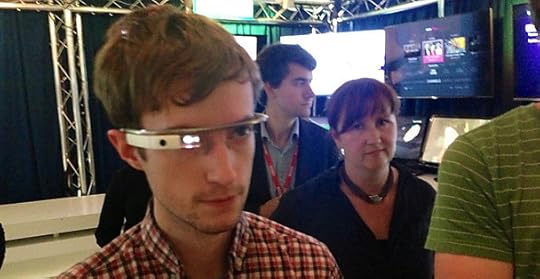
David Thair wearing Google Glass in the Blue Room.
It will be intriguing to see if and when Google make them available on a consumer level. At the moment the challenges are around security, privacy, battery life and the limited number of apps.
In an earlier Google Glass session at new Broadcasting House Rory Cellan-Jones asked Bob if he sees them as a valid news tool - if it’s realistic to shoot video content on Glass when you can’t frame your shots. Who knows, potentially there could be a greater uptake within user generated content. Whichever it is, there are definitely opportunities for both content and consumption and as Glass evolves, new and interesting ways of use will emerge.
I’m wondering how long it will be before the word ‘glasshole’ enters our vocabulary from across the pond.
For more updates on what we showcase in the Blue Room follow @BBCBlueRoom.
Lindsey Suter in a Consumer Technologist in the BBC Blue Room

Google glass in the Blue Room
September 19, 2013
New BBC Digital Design Roster: Call For Entries
Hi.
I'm Executive Creative Director for BBC User Experience & Design (UX&D). We are very excited to offer the chance for world class user experience and design agencies of all sizes and specialisms to join our new BBC Digital Design Services roster.
The new roster aims to help the BBC:
• Drive innovation and creativity
• Provide value for money
• And continually improve the quality of our digital products and services.

We will select up to seven agencies to join a roster with a life of 2-4 years, effective from 1st April 2014. Over that time we expect to reward £3-4.5m in contracts. The Pre-Qualification Questionnaire is available now on Bravo Solutions (log in required).
If your agency is selected, you will be working on:
- a number of the BBC’s digital products, including iPlayer, Radio, Homepage, Search, News, Weather, Sport, Knowledge & Learning and CBBC and CBeebies
- a variety of digital devices, including desktop, tablet, mobile and connected TVs
- developing innovative new digital features and potentially helping us to explore new platforms as they come to market
- contributing to the evolution of the BBC’s Global Experience Language (GEL)
- contributing to the BBC’s UX&D strategy.
We expect every agency selected for the roster to offer outstanding visual design and interaction design, but we also want our selection to show a diversity of other specialist skills, such as design strategy, design for children, prototyping, brand development, and so on.
We are eager to be an excellent client, not just on paper, but also when working together day-to-day. We expect to start building strong working relationships with you right from the outset as you work through our selection process.
This presentation (N.B. on Slideshare) gives an overview of what we’re looking for, and how the selection and tendering process will work.
Please have a read now, and if you’re up for it:
1) register on the BBC’s e-tendering service, BravoSolutions (login required)
2) throw your hat in the ring for the ‘Digital Design Services PQQ’ (the deadline for this stage is 7th October 2013)
Please also note that while we expect the majority of our product-based UX&D work to be offered to the agencies on this new roster, there will be a further opportunity later this year for agencies to also apply for a more broadly-based framework of digital service suppliers. More information about this will be published here on the blog and via Bravo Solutions in due course.
Any questions about the new Digital Design Roster should be sent to us via BravoSolutions (login required) by 23 September 2013. You can also leave a comment.
Good luck!
Colin Burns is Executive Creative Director, BBC User Experience and Design
September 17, 2013
The Blue Room at IFA
Hi there, I'm a consumer technologist for BBC Blue Room, where we look at key trends in consumer technology and how they are affecting the broadcast industry. Myself and fellow Blue Roomer Alison Hunter have just returned from IFA, the consumer electronics show in Berlin.
This year the consumer was at the heart of the show with manufactures focusing more on what they want and how they want it. The connected home gets closer to a reality with voice controlled ovens, TV goes round the bend and we're now talking to our watches.

From the Blue Room's slides from IFA
Here's our ebook with 10 things we learnt (N.B. in PDF format via Slide Share).
Please download and share. And follow The Blue Room on Twitter for more details of what we do.
Lindsey Suter is a Consumer Technologist in the BBC Blue Room
September 16, 2013
Open Post: September 2013
It’s been more than a year since the last "open post" on the Internet blog.
Now the blog is sitting soundly on iSite after the migration earlier this year, this seems like a good time to have another one.
If you’re new to the blog the purpose of an open post is to give you the opportunity to make a comment, ask a question or have a conversation about any aspect of the work of BBC Future Media or BBC Online.
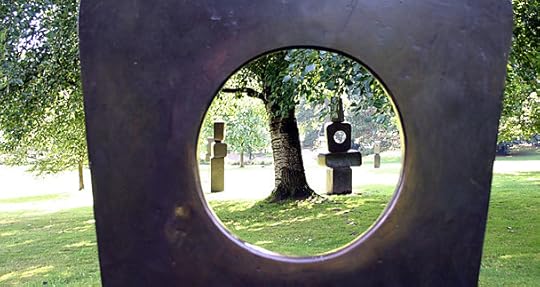
I’d also be interested if you have any subjects you’d like the blog to cover more intensively. UX&D? Software development? Mobile? Data? The Cloud? Leave a comment as I’m always looking new ideas and angles.
The following caveats apply:
1. Comments need to abide by the BBC’s House Rules. Keep the conversation civil please
2. If you want to make a specific complaint about the BBC use the Complaints website
3. This open post is about the work of BBC Online – if you want to have a general discussion about the BBC, try the Points of View message board.
I can’t promise to answer every question or comment but I’ll host and do my best.
The post will be open for comments for a month.
Thanks
Nick Reynolds is Editor, BBC Internet blog
September 13, 2013
What's On BBC Red Button 14-20 September
It's a packed schedule on the Red Button this week with something for all the family. As part of Radio 3's Sound of Cinema series, the BBC Concert Orchestra and BBC Singers celebrate Europe on Film, CBBC fans will be pleased to hear we've got a Wolfblood behind-the-scenes exclusive, Victoria Derbyshire hosts a 5 live debate on Scottish independence and, for sports fans, there’s MotoGP, Great North Run highlights plus America's Cup sailing.
Scottish Independence Debate
With a year to go before the referendum on Scottish Independence, on Monday Victoria Derbyshire is in Glasgow debating the key issues. She's joined by an audience of around 300 5 live listeners and a panel of leading business owners and politicians, including Deputy First Minister of Scotland and SNP Depute Leader Nicola Sturgeon and Deputy Leader of Scottish Labour Anas Sarwar.
Monday 16 September, 10am-12pm
Radio 3 Live in Concert - Sound of Cinema
Join the BBC Concert Orchestra from Monday as they play European film music, including excerpts from The Artist and Les Miserables, together with music composed by Maurice Jarre and Ennio Morricone, live from the Watford Colosseum.
Monday 16 September
, 5.25pm-6am
Tuesday 17 September
, 6am-7am, 8pm-6am
Wednesday 18 September
, 6am-7am, 10pm-6am
Thursday 19 September
, 6am-7am, 7.30pm-6am
Friday 20 September
, 6am-7am
Wolfblood Extra
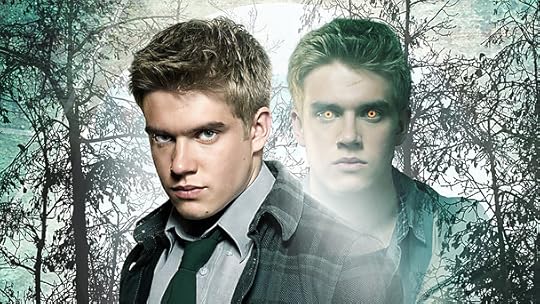
Wolfblood Extra
CBBC's hit drama series Wolfblood is back, and BBC Red Button celebrates its return with an exclusive behind-the-scenes special. From Monday, you can see how the programme is filmed, watch interviews with all the cast and get an exclusive on-set report from Dodge as he sniffs out all the Wolfblood gossip.
Also from CBBC, there's a blog from presenter Chris, horoscopes and jokes to make you laugh.
Monday 16 September, 7am-9.55am, 12-2.15pm, 3.45pm-5.25pm
Tuesday 17 September, 7am-5.40pm
Wednesday 18 September, 7am-12pm, 1.30pm-7.30pm
Thursday 19 September, 7am-12pm, 1pm-7.30pm
Friday 20 September
, 7am-2.15pm, 3.45pm-6pm
Elton John - Radio 2 In Concert

Elton John performed on Radio 2
You can still catch highlights of Sir Elton John's special concert for BBC Radio 2. The music legend performs hits from his back catalogue as well as new tracks from his 30th solo album, The Diving Board, in an intimate gig recorded at London's BBC Radio Theatre.
Saturday 14 September, 6am-8.30am, 6pm-1.15am
Sunday 15 September, 3.15pm-7.10pm
Monday 16 September
, 1.10pm-7am
Antiques Roadshow Play Along
Demonstrate your knowledge of antiques by playing along with Antiques Roadshow. Our valuation game is simple, fun and free to play. Consider each of the objects featured in the programme, select an option before our experts give their valuation and see how many you get right.
The play along is not available on Virgin TiVo but remember you can also download the BBC’s free mobile play along app.
Available on Sky and Freeview
Sun 15 September , 7.55pm-9pm
This Week's Sport Highlights
There's a packed sport schedule on Red Button this weekend with MotoGP racing from Misano, Final Score for all the latest football results, action from the UK Women's Triathlon and highlights from the Great North Run. For a full list and times of sport coverage on Red Button see the BBC Sport website. Please note times are subject to change.
And don't forget, you can get more information on BBC Red Button services here and you can keep up with all the latest news by following us on Twitter @BBCRedButton
September 10, 2013
User Experience and Design in the CBeebies Playtime App
Hi, I’m Leanne Dougan, the senior designer who led the user experience and design across the CBeebies Playtime app. This blog post aims to give you some insight into the process and approach we took to create and design a playful experience for a young audience.

CBeebies Playtime hub
CBeebies Playtime is a free mobile app for Android, IOS and Kindle. It’s filled with lots of great games, hidden surprises and fun features for children. There’s also an area for grown-ups. My colleague Lizzie has written in more depth about the app features, which can be read on the CBeebies Grown-Up Site and my colleague Jon Howard has written about how we built the app, this can be read here.
The Design Challenge
Our design challenge was to create an app that was simple to use, fun to interact with and scalable for an audience driven by image led navigation and reliant on large hit states. It needed to incorporate everything which Children love about CBeebies - the brand's humour, surprise and excitement whilst enabling children to learn through play. We also needed to make sure it suited the needs of our grown-up audience too.
First Steps
To help define the spirit of the experience we first created a mission statement and some core UX principles. Immersive, playful, personal, tactile and safe were the principles which the app design and essence needed to meet.
Keeping the mission statement and principles in mind we held a variety of creative workshops involving a BBC team comprising of an editorial producer, product manager, project manager, user experience design lead and our partner agency Mobile Pie. The creative workshops helped shape and refine the proposition further. We brainstormed areas such as how children play and what they play with, looked at game mechanics, touch screen attributes, user stories, what grown-ups would like from this app, the learning benefits and how we could give children a personalised user experience. We also discussed native game concepts for each of the brands and focused on fun navigation patterns, which would drive the user around the app.
From these workshops a series of prototypes were created to test navigation models and game mechanics. One of the navigation models we tested was based on a wheel. We weren’t looking for feedback on the visuals at this stage but simply wanted to research the usability of this type of interface with a young audience.
The game mechanics which we focused on utilised native device features. We wanted to investigate what gestures came naturally to the child and whether they could use device features such as tilt. Doing this reseach early on meant we could offer a more immersive experience and something different to our HTML 5 games.

Early prototypes to user test game and navigation mechanics
User Centered Design
When we began this project we had no doubt that users would be central to the design process and we would need to test our ideas and designs often. Children and their parents or carers were engaged throughout the project lifecycle helping to shape the design of the app.
Children are driven to content via strong imagery and in particular it’s the show characters that the audience really connect with. This led us to use a navigation model which was brand driven. The navigation achieved the aspiration of a playful interface utilising a rotating wheel mechanic. This proved to be an optimal way of designing an interface which was scalable and from our early prototypes we learnt that the children found turning the wheel fun. Internally we called this section of the app the hub.
We next started to look at user journeys and how the audience would move around the app and within the games. With there being so many different tablet and mobile devices out on the market making sure the design worked across different screen sizes was a challenge we faced. We overcame this by making sure the graphics worked in screen size ratios whilst making sure the hit states stayed large enough for our users to interact with. The app UI was based on Games GEL. Games GEL is a set of standard and guidelines we adhere to when designing games across, mobile, tablet and desktop screens to make sure the users receive a consistent experience each time.
As this app is likely to be used on a shared device one of the user journey challenges we needed to solve was the ability to create multiple accounts and how to do this in a fun and enaging way which would be understood by the young audience. We achieved this by using a hot air balloon concept where a personalised balloon would carry you in and out of your CBeebies world.

Profile creation. Users can create a personalised balloon to travel in and out of the hub.
Whilst creating the user journeys we needed to keep in mind we had a dual audience to cater for. This app isn’t just for a young children but we also needed to support our grown-ups audience too. We created a separate section which would house information about the games, parent tips, learning benefits, a special message feature where the grown up could leave their little one a message and links out to the CBeebies mobile and grown-ups site. In CBeebies it’s very imporant that whatever experience we offer it must be safe –internally we call it a ‘walled garden approach’. We must limit the risk of the child navigating away to other content which may not be suitable. How we handled this is by containing grown-ups information in a seperate section to the childs space which could be accessed only by pressing and holding a text button, something which proved tricky for a young audience to interact with. Wherever a link features taking the user outside of the app, grown-ups are asked to enter a key code. This offers even more protection.
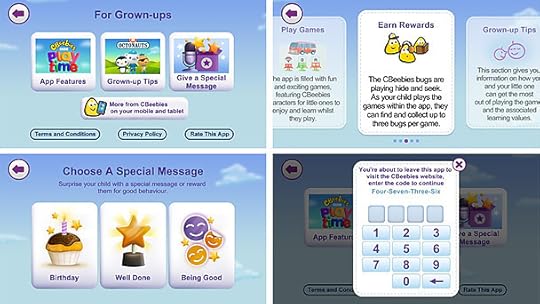
Designs of the Grown-ups section
The look and feel which we wanted to create in CBeebies Playtime was an environment which was bright and colourful whilst also holding a degree of simplicity to let the brands shine. My colleague Joseph Maguire who worked on the visual design successfully managed to create this environment whilst also giving the child space to give it their own personality. We wanted to allow them to personalise their profile with CBeebies bugs which they could win by playing the games. We also wanted to give an experience of magic and surprise and this has been achieved by the use of animation and incidentals. Hidden within the app there is a train which goes round the hub – we wanted to give an experience of being a child in a toy shop when you discover for the first time the train circling the top of the room, we wanted to evoke surprise.
Prototyping was extremely important in the shaping of this app. We ran sessions in schools and at parent & toddler groups, and my colleague Genine Keogh ran a number of more formal research session bringing participants into a research lab to help inform our design decisions. It was fantastic to watch users interact naturally and hear their thoughts, opinions and ideas along the way.
CBeebies Playtime includes 4 games, a spelling game for Alphablocks, a flying game for Tree Fu Tom, a creature rescue game for Octonauts and a popping bubble painting game for Something Special aimed at the speical needs audience. Having the opportunity to test frequently with our audience really helped to push the design forward, iron out any usability issues and helped balanced these games.

CBeebies Playtime games.
When we tested we looked out for three areas…
What worked wellWhat didn’t work wellWhat do we need to do to fix these.We asked observers to write on different coloured post it notes anything which they noticed as the prototypes were being tested. This process gave us quick insight to the usability issues and helped us to make design decisions quickly.
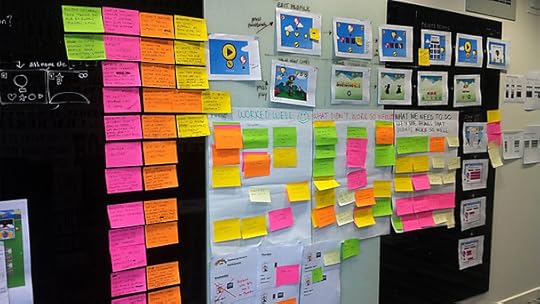
Discussing user testing findings
Testing with children always provides interesting insights into their behaviour and how they use devices. When testing the app it was interesting and surprising to see how younger users confidently interacted with the app, intuitively using swipe, drag and tilt gestures on different devices to navigate and play with the content. It was also quite striking to see how quickly children picked up and recognised icons and positioning such as those on the back and home buttons, which helped them to navigate around the app.
More fun features and games are planned for the CBeebies app but in the mean time I would love feedback so please feel free to leave any comments on our design process below.
Leanne Dougan is a Senior User Experience Designer in BBC Future Media
September 6, 2013
What's On BBC Red Button - 7-14 September
It’s the Last Night of the Proms this week and you can press red and join the celebrations from the Royal Albert Hall. We have more music plus a starry array of celebrities taking part in Radio 2’s Festival in a Day. For sports fans, there's Diamond League athletics action and it’s over to Italy for Formula 1.
Last Night of the Proms
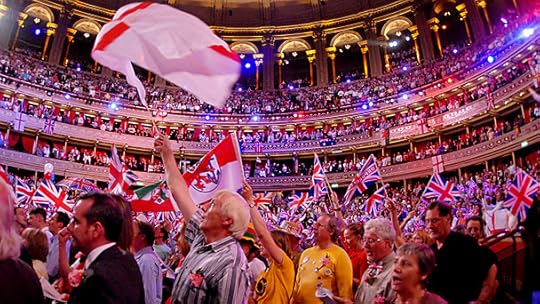
Last Night of the Proms
From 7.30pm on Saturday night viewers can press the red button to watch extracts from all four Proms in the Park, coming to you from Titanic Slipways, Belfast, Glasgow Green, Caerphilly and Hyde Park, London. We’ll show a selection of acts from those four concerts, until the party ends at around 11pm.
For the first time – you can watch all four Proms in the Park concerts live, and in full, online at www.bbc.co.uk/proms. Viewers on Virgin Tivo can also do this.
Sat 7th September, 7:25pm-10:55pm
Radio 2 in Hyde Park

Smokey Robinson live in concert at Hyde Park
BBC Radio 2 stages its 4th annual Festival in a Day from Hyde Park. Ken Bruce, Jo Whiley and Simon Mayo bring you all the action from backstage whilst a dizzying array of Radio 2 personalities including Jeremy Vine, Terry Wogan, Michael Ball, and Janice Long entertain the crowd from the stage and introduce the musical artists.
The music this year comes from 80s legends, Simple Minds, jazz great and Radio 2 presenter, Jamie Cullum, and Scottish popsters, Texas. Also appearing are Jack Johnson, Manic Street Preachers, Josh Grobin, James Blunt, and Jessie J. The evening is capped off by Motown Legend, Smokey Robinson, responsible for such classic pop hits as Tears of the Clown and I Second That Emotion.
Sun 8 September, 5:30pm-7:55pm, 9pm-11pm
Mon 9 September, 7:30pm-6am
Tue 10 September, 6:00am-10am, 7:30pm-6am
Wed 11 September, 6:00am-7:55pm, 10:00pm-6am
Thu 12 September, 6:00am-12pm
Wolfblood Secret Episode
If you are a fan of Wolfblood then you are going to love this! Watch an extra special secret episode of Wolfblood only on the Red Button. Fill in the gap between series 1 and 2 and find out what happened to Rhydian when he joined the Wild Wolfbloods. See how he met new character Jana and why he had to escape back to the human world. It’s totally exclusive and only on the Red Button.
Mon 9 September, 5:35pm-7:30pm
Tue 10 September, 5:35pm-7:30pm
Thu 12 September, 12:00pm-7:55pm
Fri 13 September, 1pm-7pm
Crimewatch
Crimewatch needs your help to track down wanted faces. Your first chance to view and report people wanted by police before the main Crimewatch programme. Will you recognise anyone?
Thu 12 September, 7:55pm-12am
Elton John
The legendary Sir Elton John performs his classic tunes in an intimate gig live from the BBC Radio Theatre, presented by Jo Whiley. Listeners can expect all the hits from his back catalogue - including new tracks from his 30th solo album, The Diving Board.
Wed 11 September, 7:55pm-10pm
Fri 13 September, 12am-12pm, 9:30pm-6am
Antiques Play Along
Demonstrate your knowledge of antiques by playing along with Antiques Roadshow. Our valuation game is simple, fun and free to play. Consider each of the objects featured in the programme, select an option before our experts give their valuation and see how many you get right.
The play along is not available on Virgin TiVo but remember you can also download the BBC’s free mobile play along app.
Available on Sky and Freeview
Sun 8 September, 7:55pm-9pm
Follow us on Twitter @BBCRedButton and find out more about BBC Red Button via bbc.co.uk/redbutton
College of Production Round Up: Crimewatch, Real Madrid, You Tube and Twitter
I’m Ben Toone, assistant content producer at the BBC College of Production (CoP) website.
The site is a free online learning resource for the radio, television and online production communities offering videos, podcasts and articles from broadcasting innovators and experts.
It’s a new term feel for the College of Production with a new look and lots of new content to talk about.
With more and more top flight football clubs, from Manchester United to Chelsea, having their own digital channels, we take a look at one the world’s most famous club's TV channel and online presence. Plus we a look at social TV, Crimewatch online and how consumer technology is changing radio.

Rhiannon Jones of Realmadrid TV
Rhiannon Jones talks about her role as a producer, presenter and reporter for Realmadrid TV, the station which broadcast the unveiling to Real Madrid fans of record breaking signing Gareth Bale. It’s interesting to see how the channel makes the most of the fervent support of Real Madrid fans from around the world, engaging them on social media platforms and with a bilingual YouTube channel.
What do Embarrassing Bodies Live, Downton Abbey and BBC Three's Free Speech all have in common? They are fantastic examples of how online and social media are key to engaging audiences beyond the reach of traditional TV, which was the theme of our BBC Academy masterclass, recorded at the recent Guardian Edinburgh International Television Festival.
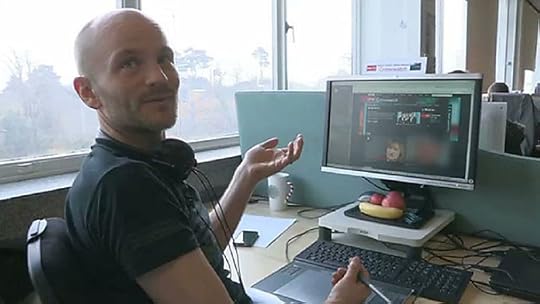
Steven Green of Crimewatch
Crimewatch has always been an interactive programme right from its inception, with viewers able to get in touch with the team of detectives working on the live shows. Now the programme's website and social media channels offer even more ways for viewers to get in touch or be informed of the latest police appeals. In this film, assistant content producer Steven Green explains how he manages the show’s Twitter account and web pages around the live show, feeding information to detectives working on the cases as well as keeping appeals alive in public minds on the website long after live broadcast.
Our regular CoP Show podcast can be found on the BBC radio iPlayer app, which gets a brief mention in the second podcast from our tour of the BBC’s Blue Room (the first, looking at TV consumer technology and programme making can be found here). This time we looked at radio, from innovations in in-car listening to apps which bring on the potential of a personalised radio experience. This opening up of choice for listeners is either a threat or a shot in the arm for radio producers. It’s exciting stuff and as the BBC Blue Rooms Garry Green puts it "We need to use this technology to make things sound better". Have a listen and tell us what you think.
Ben Toone is content producer for the BBC College of Production
September 5, 2013
BBC iPlayer Video Downloads for Android
My name is David Berlin and I am responsible for the BBC iPlayer mobile Android application.
In July, I updated you on three key areas we were working through to improve the BBC iPlayer experience for audiences with Android devices. One of these was to deliver mobile video downloads to these devices.Today, I’m pleased to announce that we are launching this feature – enabling you to download your favourite BBC TV shows for free to a range of Android devices and keep them to enjoy for up to 30 days. And, once you’ve pressed play, you can keep watching for seven more days.
The updated BBC iPlayer Android app will appear in the Google Play Store later today and it will be updated in the Amazon App Store in the coming days.
We’re launching this functionality today for a range of Android devices running Ice Cream Sandwich (ICS) and Jelly Bean. This is because these devices are able to provide the appropriate level of protection for our programmes. Our figures show this will mean 70% of Android app users with compatible devices will be able to use this functionality from today – and over the coming months we will be extending this to include new Android devices as well as some older ones. We appreciate the frustration the Android community has been experiencing in the time it has taken to deliver this desired feature, and I'm very pleased that we've now been able to deliver it.
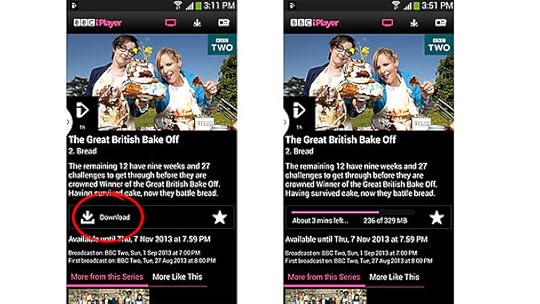
Downloading on an Android device
Due to the unique characteristics of the Android platform, we have also been able to bring you the ability to download programs while doing other things, which isn’t currently possible on iOS devices - so no need to keep the screen awake.
Following feedback, we’ve decided to default to High Quality downloads on Android tablets, due to the quality and size of screen – giving you the clearest picture. However, we always want to give you the choice to change that (as with the iOS app), so you can manually switch between Standard and High Quality downloads in the BBC iPlayer app Settings (found in the overflow menu – 3 dots or lines) to vary the download time and picture quality on phones or tablets.
We’ve also made some further improvements to the app for those Android handsets that are unfortunately not capable of the download functionality. This includes Android 4.3 support, a link to other BBC apps and addressing some known issues that will improve your overall viewing experience.

Downloading a programme on a Nexus 7
I’m really pleased that we are now able to deliver video playback quality parity with Apple iOS devices, support the full range of Android screen sizes, including tablet support and, as of today enable mobile TV download functionality to Android devices.
As I’ve discussed previously, we’re fully committed to developing fantastic services for audiences with Android devices and will be continuing to make improvements and, as ever, I thoroughly welcome your feedback.
Here's a list of devices that will support download functionality for BBC TV programmes from launch:
1) Amazon Kindle 8.9
2) Asus Nexus 7 i
3) Asus Nexus 7 ii
4) HTC One
5) LG Nexus 4
6) Samsung Galaxy S2
7) Samsung Galaxy S3
8) Samsung Galaxy S4
9) Samsung Galaxy Tab 2 7"
10) Samsung Google Nexus 10
11) Sony Xperia Z (phone)
You may have noticed that despite their popularity, the Amazon Kindle Fire 7 and Amazon Kindle Fire HD 7 are not in this list. We are currently working with Amazon to try to resolve this.
Watch this space for regular updates to the above list.
David Berlin is Senior Product Manager, TV & iPlayer Mobile Applications in BBC Future Media
September 4, 2013
Agile Delivery in the Travel Beta; from Scrum to Kanban

The ever-evolving Kanban workflow, with exit criteria at the top of each column
At the end of July 2013, the Travel team in Cardiff breathed a huge sigh of relief as the Travel Beta went live to our audiences and we could finally start to get some feedback on the thing we had been developing for so many months.
Although this felt like the end of a long road, it's actually just the beginning for the new Travel product, because we've taken a development approach that is fairly new to BBC Future Media. For the Travel Beta, we released a Minimum Viable Product as early as possible and are now iterating on the live site, responding to audience feedback, until we (and our audiences!) think we are ready to replace the current Travel site with our new version.
My name is Amanda Dahl and I'm the Delivery Manager for the BBC Homepage, Search and Navigation team, whose portfolio includes BBC Travel News. I'm also the project manager for this year's refresh of the BBC Travel site, which has been a project full of firsts for BBC Future Media, in terms of technologies and continuous deployment. Travel is one of the very first BBC Online projects to employ a new platform that enables continuous delivery, employ Scala and Dynamo DB, and it's also one of the first where we've been encouraged to make live deployments to our audiences little and often, starting far earlier in the project than we would normally. Hence, we have the Travel Beta, where we're experimenting with progressive enhancement to a live site instead of a big-bang launch. I'd like to tell you a bit about the Agile practices we used for the Travel build, especially our switch from Scrum to Kanban once the project was up and running, which helped us become more efficient and reactive to change.
The Travel product is built by the development team in Cardiff, which is a centre of excellence for all things related to location and maps for BBC Online. We've been using scrum for quite a while, and have refined our agile practices through continuous inspection and adapting. When the Travel project came along, we formed a new team so that we’d have all the right roles in place from the beginning.
As we were used to working in the confines of scrum, and had a lot of new people in the team, we began by developing the proof-of-concept using two week iterations, where each sprint had a goal, and was bounded by a demo, retrospective and planning session for the next sprint. This worked really well, and allowed the team to start to come together as a group and develop a velocity.
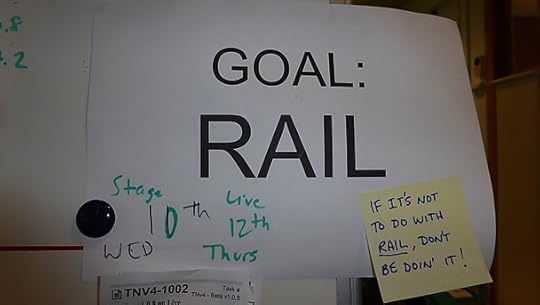
Visible goals make all the difference in maintaining focus
We finished the proof-of-concept in 4 sprints: one to tool up, setting up development practices and frameworks, and 3 sprints to code. The prototype was placed in front of audiences for user testing, and we were able to gather a lot of useful feedback, which was incorporated back into our plans for the MVP. It was around this time that we had a project retrospective for the build of the prototype. We began to understand that scrum had been a good tool for us when forming as a team, but the rigid structure of the iterations created a lot of waste, and the number of actual coding days in a sprint felt like it was dwindling because of all of the time spent planning (we generally took 3-4 hours sprint planning every other week).

Our ruthless MVP, with subsequent iterations all mapped out
We looked at why we were spending so much time in planning and came to a few conclusions.
1. Development planning was starting too early.
2. We were planning everything up front, rather than planning on-demand.
3. We would always plan in a little extra work.
With the sprint structure, there was a lot of pressure on the product owner to prepare stories for the team in advance of their sprint planning. This would often mean that not everything had been prepared by the time the stories went to the development team, and would lead to lengthy discussions during planning which could have been avoided if the stories were prepared in more depth in advance.
We decided it was time to give Kanban a try, as we had seen it work for a few other BBC teams. There were a number of advantages we could see with moving to Kanban, including:
• Moving from fortnightly all-day planning sessions to planning on-demand as work is pulled across into Development
• Having a closer model of our end-to-end process would help us better to reflect the reality of our workflow from initial concept to live deployment
• A continuous flow would mean an end to the lull that inevitably happens between code-cutoff and the beginning of the next sprint
Before we made the switch from Scrum to Kanban, we talked to a couple of other BBC teams about what they've learned from their transitions to Kanban. We also sat down as a team and listed out every possible step we go through to get from an idea to a fully-developed feature. We turned each step into a column on our new Kanban board, each marked with the exit criteria required for the column. We soon learned that some columns could be combined to be more efficient/less wasteful, and others needed to be split out to better reflect where queues were forming in our flow. We didn't impose Work in Progress limits at first, because we didn't know where to set them, but this has evolved over time, and now we have a few WIP limits in place where queues were forming.
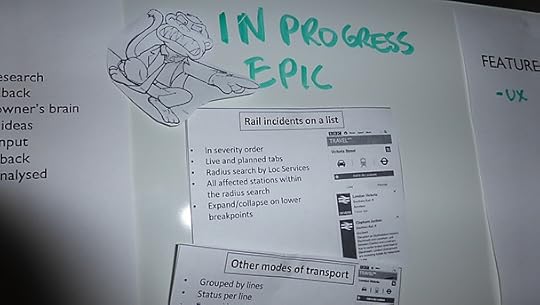
Constraining our workflow to a single, well-defined Epic in order to keep focus
We've been running the Kanban boards for 7 months now, and just last week we added a new column and split out some swim lanes. It's an ever-adapting process of improving how we reflect our workflow on the board and trying to optimise flow.
Lessons learned
Many of the lessons we learned from the Travel project so far have been general ones related to developing good agile practices, but some are related to the switch from Scrum to Kanban:
1. Good goals are extremely important.
Just because you lose 2-week iterations, doesn't mean you should lose your clear goals. One of the biggest advantages of scrum iterations was that the goal of the sprint was set every 2 weeks and evaluated for completion at the end of the iteration. It meant that everyone had a clear target to focus on, and would tend to pull together around it, where possible. But it also meant that we had to artificially fill a 2-week hole with work if the goal didn't require a whole team pushing towards it for the whole sprint. When we moved to Kanban, we no longer felt confined to the 2 week period, with all of the overhead of scrum rituals every other week, but at the same time we lost sight of the goals to some extent, and had to find other ways to gain a sense of urgency.
2. Make sure your Kanban board reflects the truth of how you work.
It will take a while to model your system – inspect and adapt your kanban workflow, adding columns and removing them until what you have on your wall board reflects your reality, as much as possible.
3. WIP limits really do help maintain focus.
Throttle the number of epics you allow onto your board – keep the ‘work in progress’ limit low for the number of features or epics the team is working on at any given time, this will keep everyone focused on the goal at hand and stop them from context-switching. Notice where queues are forming and introduce WIP limits in the column before, to control the build up.
4. Shape and define the work well and half the battle is won.
Once we modelled the steps that a piece of work goes through before it even gets to development, we started to see the development team spending far less time debating during planning sessions, instead they were able to plan on-demand when pulling the next bit of work along the Kanban board. Clear, prioritised goals, with full definition of features and technical architecture will help work flow across the board.
5. Release early, release often - it's harder to do than you think.
Learn to understand when a feature is good enough to get out there for some feedback, and try to lose the fear of releasing -- it can often be more beneficial to get something out the door before you think it's entirely ready (just to get early feedback) than to hold onto it and wait for it to be polished because that feedback might be a major change to the feature anyway. Never underestimate the impact of adopting a new platform or technology on the ability to release production-ready code early in the project.
You need to allow for the uncertainty which comes along with early adoption of new technology, the learning curve it will bring, and factor this into your development approach, ideally coding for functionality before refining it for performance.
Amanda Dahl is a delivery manager in Homepage, Search, Navigation, Travel News and Location Services, News and Knowledge, BBC Future Media
BBC's Blog
- BBC's profile
- 28 followers



